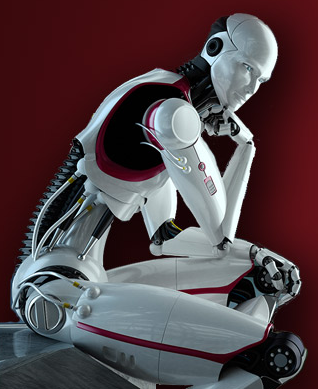 |
| Source |
Nicholas West
Activist Post
Worldwide neuroscience research conducted under Obama’s BRAIN project, as well as similar research sponsored by the European Union exceeds $1 billion combined. The goal is nothing short of decoding the human brain. While there are many embedded initiatives associated with this type of research, the production of artificial intelligence that can rival or even surpass humans is at the forefront.
One recent development aims to move beyond mere computational horsepower and incorporate the principles of Darwinian evolution in order to naturalize the process of robot evolution.
This initiative has become evident in the European Union’s cloud network called RoboEarth where robots can do their own research, communicate with one another, and collectively increase their intelligence by mimicking family and cultural learning.
This drive for embedding evolutionary principles into robotics formed the cornerstone of the next phase of research begun at the University of Wyoming’s Evolving Artificial Intelligence Lab, seen in the video below, where the stated goal is to introduce survival of the fittest to hopefully break through current evolutionary barriers toward fully intelligent robots.
As you heard, willful procreation is a natural outcome. This has been echoed by George Zarkadakis, an artificial intelligence engineer, who believes that intelligent robots will move toward procreation as they desire to produce superior offspring. Through a simple software swap, new intelligence could be created, as well as the likelihood of other upgrades like virus protection. Incidentally, the organic component of this is also being researched by geneticists as downloadable DNA via our own human Internet.
Just as we humans wish that our own children become healthier, more intelligent and longer-lived versions of ourselves, so too will increasingly self-aware robotic systems. The research at the University of Wyoming has embraced this potential.
Further commenting on the potential of the “mutations” and code swaps, lead researcher Jeff Clune stated:
We’re trying to harness the power of evolution. It’s an extremely creative and powerful design force. Can we use that process to evolve robots? We can harness it, and when we do, evolution comes up with something smarter than humans can design.
[…]
We want to engineer robots that rival nature and are as agile and smart. (emphasis added)
 However, robots that rival their human counterparts is exactly the scenario that is being warned about. Some of the many unintended consequences erupting from a superintelligence have been articulated by Nick Bostrom. The response to a “rival” humanity by this superintelligence could involve operational enslavement or eradication, just as it has among animal and human groups throughout history. Despite such tech luminaries as Stephen Hawking and Elon Musk being moved by Bostrom’s research and existential concern, research continues apace.
However, robots that rival their human counterparts is exactly the scenario that is being warned about. Some of the many unintended consequences erupting from a superintelligence have been articulated by Nick Bostrom. The response to a “rival” humanity by this superintelligence could involve operational enslavement or eradication, just as it has among animal and human groups throughout history. Despite such tech luminaries as Stephen Hawking and Elon Musk being moved by Bostrom’s research and existential concern, research continues apace.
A similar program from Michigan State University “uses genetic algorithms operating on a mathematical framework called Markov networks to model a large population of robot ‘brains’ working on a particular task, like finding the exit to a maze. The brains that perform the task best have the largest number of simulated ‘offspring.'” Researchers point to the ability to easily speed up the process of natural selection, which could theoretically produce intelligence and consciousness in the relatively near term. Team leader, Chris Adami, specifically cites the ability to equip a new robot brain with the results from “hundreds of thousands of generations.”
Once equipped, robots can illustrate marked evolutionary principles such as cooperation and, eventually, self-awareness.
Adami believes that evolving robot brains in complicated worlds that force them to interact with each other is the best path toward self-aware intelligence. “When robots have to make models of other robots’ brains, they are thinking about thinking,” he said. “We believe this is the onset of consciousness.”
Adami then issues a rather tepid dismissal of those who are worried about what these conscious robots would exactly wish to accomplish:
Thinking robots will be extraordinarily useful, Adami says, adding that humanity should have no reason to fear a rise of the machines. “When our robots are ‘born’, they will have a brain that has the capacity to learn, but only has instincts. It will take a decade or two of exploration and training for these robots to achieve human-level intelligence, just as is the case with us,” he said.
At best, we see that there is certainty about the birth of conscious and self-aware robots operating on the principles of survival of the fittest … and that humanity has a hopeful stay of execution date in a decade or two.
Sources:
http://phys.org/news/2015-03-evolving-robot-brains.html
http://www.33rdsquare.com/2014/05/using-evolution-to-advance-intelligent.html
Recently by Nicholas West:

Be the first to comment on "Scientists Continue Path of Darwinian Evolution for Robots"